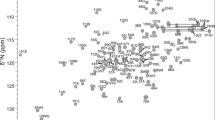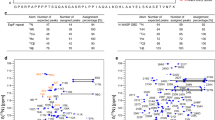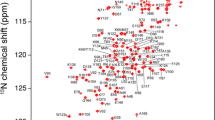Abstract
Type II secretion systems (T2SS) allow Gram-negative bacteria to transport toxins and enzymes from the periplasm to the external milieu, and are thus important for the pathogenicity of bacteria. To drive secretion, T2SS assemble filaments called pseudopili closely related to bacterial type IV pili. These filaments are non-covalent polymers of proteins that are assembled by an inner membrane complex called the assembly platform connected to a cytoplasmic ATPase motor. In the Klebsiella oxytoca T2SS, the PulL protein from the assembly platform is essential for pseudopilus assembly and protein secretion. However, its role in these processes is not well understood. To decipher the molecular basis of PulL function, we used solution NMR to study its structure and interactions with other components of the machinery. Here as a first step, we report the 1H, 15 N and 13C backbone and side-chain chemical shift assignments of the C-terminal periplasmic domain of PulL and its secondary structure based on NMR data.



Similar content being viewed by others
Data Availability
The chemical shift values have been deposited in the BioMagResBank (http://www.bmrb.wisc.edu/) under the accession number 50966.
Code Availability
Not applicable.
References
Abendroth J, Bagdasarian M, Sandkvist M, Hol WG (2004a) The structure of the cytoplasmic domain of EpsL, an inner membrane component of the type II secretion system of Vibrio cholerae: an unusual member of the actin-like ATPase superfamily. J Mol Biol 344:619–633
Abendroth J, Murphy P, Sandkvist M, Bagdasarian M, Hol W (2005) The X-ray structure of the type II secretion system complex formed by the N-terminal domain of EpsE and the cytoplasmic domain of EpsL of Vibrio cholerae. J Mol Biol 348(4):845–855
Abendroth J, Rice AE, Mcluskey K, Bagdasarian M, Hol WG (2004b) The crystal structure of the periplasmic domain of the type II secretion system protein EpsM from Vibrio cholerae: the simplest version of the ferredoxin fold. J Mol Biol 338:585–596
Berry J, Pelicic V (2015) Exceptionally widespread nanomachines composed of type IV pilins: the prokaryotic Swiss Army knives. FEMS Microbiol Rev 39:134–154
Camberg JL, Sandkvist M (2005) Molecular analysis of the Vibrio cholerae type II secretion ATPase EpsE. J Bacteriol 187:249–256
Cavanagh, J., Fairbrother, W. J., Palmer III, A. G. & Skelton, N. J. (1996) Protein NMR spectroscopy: principles and practice, New York, NY, U.S.A.
Cianciotto NP, White RC (2017) Expanding role of Type II secretion in bacterial pathogenesis and beyond. Infect Immun 85:00014–00017
D’enfert C, Ryter A, Pugsley AP (1987) Cloning and expression in Escherichia coli of the Klebsiella pneumoniae genes for production, surface localization and secretion of the lipoprotein pullulanase. The EMBO J 6:3531–3538
Denise R, Abby S, Rocha E (2019) Diversification of the type IV filament superfamily into machines for adhesion, protein secretion, DNA uptake, and motility. PLoS Biol 17(7):3000390
Favier A, Brutscher B (2019) NMRlib: user-friendly pulse sequence tools for Bruker NMR spectrometers. J Biomol NMR 73(5):199–211
Fulara A, Vandenberghe I, Read RJ, Devreese B, Savvides SN (2018) Structure and oligomerization of the periplasmic domain of GspL from the type II secretion system of Pseudomonas aeruginosa. Sci Rep 8:16760
Hardie KR, Lory S, Pugsley AP (1996) Insertion of an outer membrane protein in Escherichia coli requires a chaperone-like protein. EMBO J 15(5):978–988
Lallemand M, Login FH, Guschinskaya N, Pineau C, Effantin G, Robert X, Shevchik VE (2013) Dynamic interplay between the periplasmic and transmembrane domains of GspL and GspM in the type II secretion system. PLoS ONE 8:e79562
López-castilla A, Thomassin J, Bardiaux B, Zheng W, Nivaskumar M (2017) Structure of the calcium-dependent type 2 secretion pseudopilus. Nat Microbiol 2:1686–1695
Nivaskumar M, Francetic O (2014) Type II secretion system: a magic beanstalk or a protein escalator. Biochim Biophys Acta 1843:1568–1577
Patrick M, Korotkov KV, Hol WG, Sandkvist M (2011) Oligomerization of EpsE coordinates residues from multiple subunits to facilitate ATPase activity. J Biol Chem 286(12):10378–10386
Possot OM, Letellier L, Pugsley AP (1997) Energy requirement for pullulanase secretion by the main terminal branch of the general secretory pathway. Mol Microbiol 24:457–464
Possot OM, Vignon G, Bomchil N, Ebel F, Pugsley AP (2000) Multiple interactions between pullulanase secreton components involved in stabilization and cytoplasmic membrane association of PulE. J Bacteriol 182:2142–2152
PY B, Loiseau L, Barras F (2001) An inner membrane platform in the type II secretion machinery of Gram-negative bacteria. EMBO Rep 2:244–248
Sauvonnet N, Vignon G, Pugsley AP, Gounon P (2000) Pilus formation and protein secretion by the same machinery in Escherichia coli. EMBO J 19:2221–2228
Shen Y, Bax A (2013) Protein backbone and sidechain torsion angles predicted from NMR chemical shifts using artificial neural networks. J Biomol NMR 56:227–241
Vranken WF, Boucher W, Stevens TJ, Fogh RH, Pajon A, Llinas M, Ulrich EL, Markley JL, Ionides J, Laue ED (2005) The CCPN data model for NMR spectroscopy: development of a software pipeline. Proteins 59:687–696
Wishart D, Bigam C, Yao J, Abildgaard F, Dyson H, Oldfield E, Markley J, Sykes B (1995) 1H, 13C and 15N chemical shift referencing in biomolecular NMR. J Biomol NMR 6:135–140
Acknowledgements
This work was funded by the Institut Pasteur, the Centre National de la Recherche Scientifique (CNRS), the French Agence Nationale de la Recherche (ANR Synergy-T2SS ANR-19-CE11-0020-01), the Fondation pour la Recherche Médicale (Equipe FRM 2017M.DEQ20170839114). We thank Rémy Le Meur and Bruno Vitorge for their help in NMR experiments.
Author information
Authors and Affiliations
Contributions
All authors: (1) made substantial contributions to the conception or design of the work; or the acquisition, analysis, or interpretation of data; (2) drafted the work or revised it critically for important intellectual content; (3) approved the version to be published; and (4) agree to be accountable for all aspects of the work in ensuring that questions related to the accuracy or integrity of any part of the work are appropriately investigated and resolved.
Corresponding author
Ethics declarations
Conflict of interest
The authors declare they have no conflict of interest.
Ethical approval
The experiments comply with the current laws of France. The corresponding author, Nadia Izadi-Pruneyre, serves as guarantor for the article and accepts full responsibility for the work and the conduct of the study.
Additional information
Publisher's Note
Springer Nature remains neutral with regard to jurisdictional claims in published maps and institutional affiliations.
Rights and permissions
About this article
Cite this article
Dazzoni, R., López-Castilla, A., Cordier, F. et al. 1H, 15 N and 13C resonance assignments of the C-terminal domain of PulL, a component of the Klebsiella oxytoca type II secretion system. Biomol NMR Assign 15, 455–459 (2021). https://doi.org/10.1007/s12104-021-10045-4
Received:
Accepted:
Published:
Issue Date:
DOI: https://doi.org/10.1007/s12104-021-10045-4




